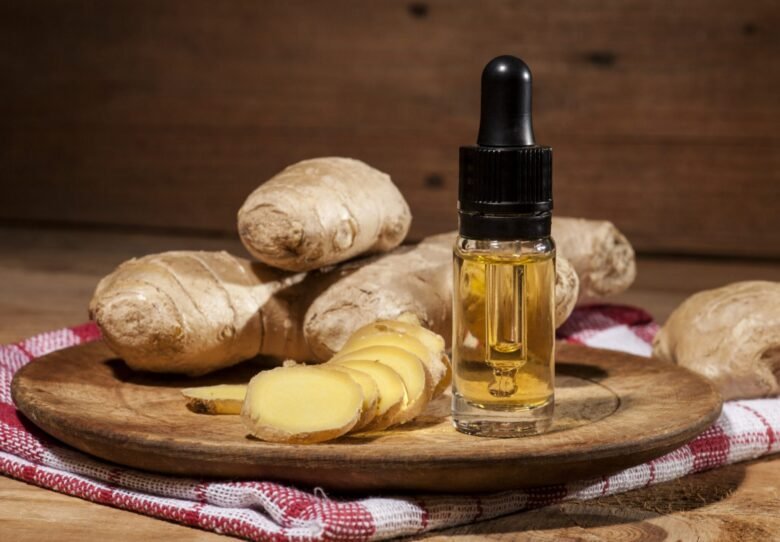Ginger has long been celebrated not only for its digestive benefits but also for its powerful anti-inflammatory and analgesic properties. The root of the ginger plant contains bioactive compounds, particularly gingerols and shogaols, which have been shown to reduce inflammation, relieve pain, and improve circulation. These properties make ginger an excellent natural remedy for muscle pain, joint inflammation, and soreness.
Making your own ginger-infused oil is an easy and cost-effective way to harness the benefits of ginger directly on your skin. This DIY ginger oil can be used to alleviate muscle tension, reduce inflammation, and ease discomfort associated with physical activity, chronic pain, or injury.
In this comprehensive guide, we’ll walk you through the step-by-step process of making ginger oil at home, how to use it for muscle pain and inflammation, and the additional benefits it offers.
Why Ginger Oil is Effective for Muscle Pain and Inflammation
Ginger oil works well for muscle pain and inflammation due to the following reasons:
- Anti-inflammatory Properties: Gingerols, the active compounds found in ginger, have strong anti-inflammatory effects. By reducing inflammation in the muscles and joints, ginger oil can help ease pain, swelling, and stiffness.
- Pain Relief: Ginger contains compounds that act as analgesics (pain relievers), helping to alleviate chronic pain or discomfort caused by conditions like arthritis, muscle strains, or fibromyalgia.
- Increased Blood Flow: Ginger is known to promote better circulation by stimulating blood flow, which is especially helpful for sore muscles and stiff joints. It can increase oxygen and nutrient delivery to tissues, promoting faster recovery.
- Muscle Relaxation: Applying ginger oil to tight muscles helps to relax the muscles and relieve tension, which can reduce spasms and stiffness.
- Antioxidant Properties: The antioxidants in ginger help protect against oxidative stress, which can contribute to muscle fatigue and inflammation.
How to Make DIY Ginger Oil for Muscle Pain and Inflammation
You can create a ginger-infused oil at home using fresh ginger root and carrier oils such as coconut oil, olive oil, or jojoba oil. Here’s a detailed, step-by-step guide on how to prepare your own ginger oil:
Ingredients:
- Fresh ginger root (about 2-3 inches of ginger)
- Carrier oil (such as coconut oil, olive oil, or sweet almond oil) – 1 cup
- A small jar or glass container for storing the oil
- Optional: Vitamin E oil or lavender oil (for added skin benefits and a calming scent)
Instructions:
- Prepare the Ginger Root:
- Peel the fresh ginger using a spoon or knife to remove the skin. You can also scrub it well if you prefer to keep the skin on for extra nutrients.
- Grate the ginger root using a fine grater or chop it into small pieces. This helps increase the surface area, allowing the ginger to infuse better into the carrier oil.
- Choose Your Carrier Oil:
- The choice of carrier oil is important because it will serve as the base for your ginger infusion. Coconut oil is a popular option due to its moisturizing and anti-inflammatory properties. Olive oil is rich in antioxidants and helps hydrate the skin. Sweet almond oil is another excellent choice, known for its gentle and nourishing effects on the skin.
- Use about 1 cup of carrier oil for a small batch of ginger oil. You can increase the amount if you want to make a larger quantity.
- Infusing the Ginger in the Oil:
- Method 1: Cold Infusion (Best for preserving nutrients)
- Add the grated or chopped ginger to a small glass jar. Pour the carrier oil over the ginger, ensuring that it is completely submerged.
- Seal the jar and place it in a warm, sunny spot for about 1-2 weeks. Shake the jar gently every couple of days to mix the ginger with the oil.
- After 1-2 weeks, strain the oil using a fine mesh strainer or cheesecloth to remove the ginger bits.
- Method 2: Heat Infusion (Faster Process)
- In a double boiler, add the grated ginger and the carrier oil. Heat the mixture on low to medium heat for about 2-3 hours, stirring occasionally. Be sure to keep the heat low to avoid overheating and damaging the oil.
- Once the oil has taken on a ginger aroma, remove the mixture from heat and let it cool.
- Strain the oil to remove any ginger pieces, and pour the finished ginger oil into a clean jar or bottle for storage.
- Method 1: Cold Infusion (Best for preserving nutrients)
- Optional Additions:
- If you want to boost the benefits of the oil, you can add Vitamin E oil (a natural preservative and skin-soothing agent) to extend the shelf life of your ginger oil. A few drops of lavender oil can also be added for its calming and muscle-relaxing properties.
- Storage:
- Store your homemade ginger oil in a cool, dark place for up to 6 months. If you’ve used coconut oil, it will solidify at lower temperatures, but it will melt once warmed.
How to Use Ginger Oil for Muscle Pain and Inflammation
Once you’ve made your ginger oil, it’s time to incorporate it into your muscle pain relief routine. Here’s how to use it effectively:
1. Massage for Muscle Pain Relief
One of the most effective ways to use ginger oil for muscle pain is through a gentle massage. The rubefacient properties of ginger oil help improve circulation, soothe sore muscles, and reduce pain and inflammation.
- How to use:
- Apply a small amount of ginger oil to the affected area.
- Gently massage it into the skin in a circular motion for 5–10 minutes. The oil will warm up your skin and penetrate deeply into the muscles, promoting relaxation and pain relief.
- Repeat this process 2–3 times daily for best results.
2. Ginger Oil Bath Soak
If you prefer a more soothing treatment, you can use ginger oil in your bath to ease full-body muscle aches and inflammation.
- How to use:
- Add 5–10 drops of ginger oil to your warm bathwater.
- Soak in the bath for 20–30 minutes to allow your muscles to relax and benefit from the anti-inflammatory and pain-relieving properties of ginger.
- For added benefits, you can combine ginger oil with Epsom salts or lavender oil for a calming, therapeutic experience.
3. Use in a Warm Compress
A warm compress with ginger oil can be a great way to target localized muscle pain or inflammation.
- How to use:
- Soak a washcloth in hot water, then wring it out.
- Add a few drops of ginger oil to the damp washcloth and apply it to the sore or inflamed area.
- Leave the compress on for 10–15 minutes to allow the warmth and ginger oil to penetrate the muscles.
4. DIY Ginger Oil Rub for Joint Inflammation
If you’re dealing with joint pain, such as arthritis or tendonitis, ginger oil can be used as a topical rub to reduce swelling and pain.
- How to use:
- Apply a generous amount of ginger oil to the affected joint or area.
- Gently massage the oil into the skin, using circular motions.
- Leave the oil on for at least 30 minutes, or cover the area with a bandage or wrap for longer relief.
- Repeat this 1–2 times daily.
Additional Benefits of Ginger Oil for Skin and Overall Health
Besides its muscle pain and inflammation-relieving effects, ginger oil also offers several skin benefits:
- Improves Circulation: The stimulating properties of ginger oil help boost blood flow, promoting healthier, more vibrant skin.
- Fights Acne: Ginger’s antioxidant and anti-inflammatory properties can help reduce acne breakouts by balancing oil production and reducing skin irritation.
- Soothes Skin Irritation: Ginger oil can provide relief from skin conditions like eczema, psoriasis, and itchiness, helping to calm and heal irritated skin.
Precautions and Considerations
While ginger oil is generally safe for topical use, there are a few precautions you should consider:
- Patch Test: Before applying ginger oil to a large area, do a patch test on a small portion of your skin (such as your forearm) to check for any allergic reactions or irritation.
- Dilution: Ginger oil is potent, so always dilute it with a carrier oil before applying to the skin to avoid irritation.
- Avoid Open Wounds: Do not apply ginger oil to broken or sensitive skin, as it may cause irritation.
- Pregnancy and Medical Conditions: If you’re pregnant or have a medical condition (e.g., blood-clotting disorders), consult with a healthcare provider before using ginger oil.
Conclusion
DIY ginger oil is a natural, effective, and budget-friendly way to alleviate muscle pain and inflammation. By creating a ginger-infused oil at home, you can tap into the natural healing properties of ginger, offering a soothing remedy for aches, stiffness, and soreness. Whether you use it for a gentle massage, bath soak, or compress, ginger oil is a versatile addition to your self-care routine.
With its anti-inflammatory and analgesic properties, ginger oil can help you feel more comfortable, relaxed, and pain-free. Just follow the simple steps to create your own homemade ginger oil and start reaping the benefits of this natural remedy today!




